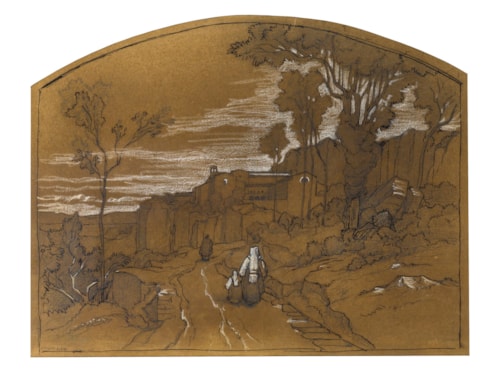
François Édouard BERTIN
Paris 1797 - Paris 1871
Biography
Edouard Bertin enrolled as a pupil of Anne-Louis Girodet at the École des Beaux-Arts in 1815, and the following year also began studying with the landscape painter Jean-Joseph Bidauld. Later in his career he spent some time in the studio of Jean-Auguste Dominique Ingres, who in 1832 was to paint a celebrated portrait of Bertin’s father, the founder and editor of the Journal des débats. The younger Bertin competed unsuccessfully for the Prix de Rome in 1821, in the category of the paysage historique, and later that year made his first visit to Italy.
Bertin made eleven separate visits to Italy, spending a total of some eighteen years in the country, whose landscapes were to be a source of inspiration throughout his career. He made numerous sketching and painting excursions into the Roman countryside in the company of Jan-Baptiste-Camille Corot and Théodore Caruelle d’Aligny and also ventured south to Ischia, Capri and Sorrento. Bertin also visited Sicily, Belgium, Holland, Switzerland, Germany and Spain, as well as Greece and Asia Minor in 1845 and Egypt in 1853. He showed numerous Italian views at the Paris Salons between 1827 and 1853, as well two important religious pictures; a Christ in the Garden of Gethsemane exhibited at the Salon of 1837 and a Temptation of Christ, shown five years later. In 1854 he took over the Journal des débats after his elder brother’s death, and although he continued to paint and draw, he no longer exhibited at the annual Salons.
In the preface to the catalogue of a posthumous exhibition of Bertin’s work held at the École des Beaux-Arts in 1872, the critic and art historian Charles Clément noted of Bertin that ‘Ses tableaux et ses dessins sont peu connus du public, mais dans ce demi-jour dont il enveloppe volontairement ses ouvrages, il y a des richesses qu’il n’est pas possible d’apprécier complètement dès à présent.’ Alfred de Musset, writing of a landscape exhibited by Bertin at the Salon of 1836, noted that ‘M. Bertin semble avoir transporté dans le paysage, invention moderne, l’amour de la plastique, cher à l’Antiquité. On sent qu’il cherche la beauté e la forme et du contour depuis les masses de ses rochers jusque dans les feuilles de ses arbres qui se découpent sur le ciel. Ses tons sont larges et fins de la nature, qu’il étudie, est grave et noble sous son pinceau...Je ne chercherai pas ce qui lui manque; rien ne me choque, et tout me plaît.’ (in Revue des Deux Mondes, 1836).
Significant groups of drawings by Bertin are in the collections of the Louvre and the École des Beaux-Arts in Paris, the Musée des Beaux-Arts in Orléans, the Musée Départemental de l’Oise in Beauvais, the Musée de Picardie in Amiens and the Musée des Beaux-Arts in Chartres; the latter houses a particularly fine group of nearly 140 landscape drawings by the artist.


